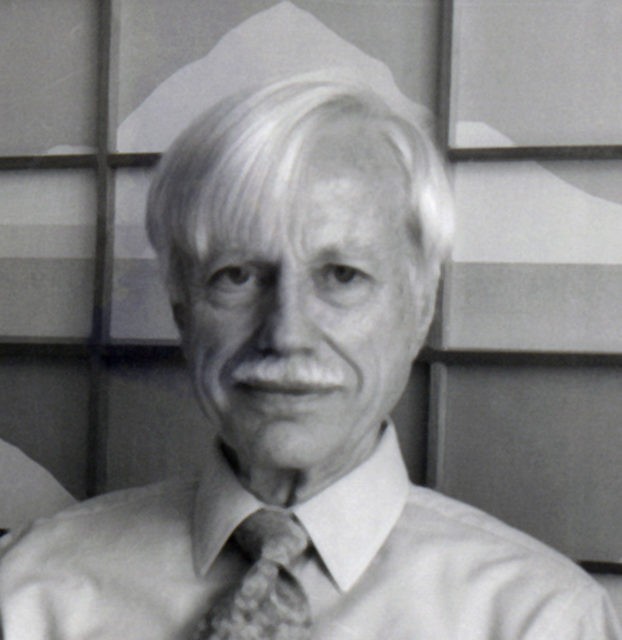
Howard Ben Tré talks about Providence and discusses architectural geometry and the use of copper in his work in an interview with Paul Hollister from 1980.
04:15Howard Ben Tré talks about Providence and discusses architectural geometry and the use of copper in his work in an interview with Paul Hollister from 1980. Interview with Howard Ben Tré by Paul Hollister, May 1, 1980 (Rakow title: Howard Ben Tré interview / with Paul Hollister, BIB ID: 168628) Clip length: 04:15.
Time stamp: 00:00
Clip 1: Howard Ben Tré talks about Providence with Paul Hollister. Clip length: 01:33.
Paul Hollister (PH): This is May 1, 1980, Howard Ben Tré—Yeah—
Howard Ben Tré (HBT): May Day.
PH: —you came from New York—
HBT: —yeah, I grew up in New York—
PH: —and then you went—
HBT: —and then I went to Oregon—I almost went to Oregon to try and deny being so much a part of this kind of old, industrial world that I was living in. And then when I came back to Providence, and I got a studio in an industrial building, and I looked out my window and there were railroad tracks, and I just started—the world started changing and I guess I just really started working out all the things from my youth that had been a part of that industrialized system. You know, I had gone to an engineering high school and all those types of things. I know it had just sort of reflected it—it’s started to reflect itself—
PH: That’s when you went to the RISD [Rhode Island School of Design].
HBT: —right, right.
PH: And so the—Providence was always the thing that I went through on the train, it had, it was all machinery, and factories and so forth, we, it’s so long we don’t have to continue—
HBT: —oh that’s fine. [laughs]
PH: —we can do it some other time. But—
HBT: Yeah, that’s what Providence is, it’s just sort of a dying industrial town.
PH: Which is reviving in an almost chichi—
HBT: Uh-huh—
PH: —you see—
HBT: —they’re redoing that—
PH: —the arcade—
HBT: —the arcade, you know—
Time stamp: 01:35
Clip 2: Howard Ben Tré speaks about architectural geometry in his work. Clip length: 01:37.
Howard Ben Tré (HBT) Well, you know how my earlier work was very much a—it was a little smaller, it was very much a kind of investigation of those architectonic geometry that, that all the different civilizations—Mayan or Egyptian—
Paul Hollister (PH): Yeah.
HBT: —Persian and—
PH: Yeah.
HBT: And, then, well once again, when sort of I moved back here—I was, I felt like I should, sort of, update my vocabulary—
PH: Mm-hmm.
HBT: —and what I started finding was that [inaudible] man-made geometries, and they had just sort of, changed size, and they had become parts, or part of our industrialization. And, and hadn’t really, the geometries were the same and that’s why it’s sort of interesting that you would say that, but they look, you know I don’t know if this is Persian.
PH: Well, what do you mean when you say changed size?
HBT: Well, as opposed to being architectural. Although they still are that. They very much became, this size, it became mechanical size, it [inaudible] but mostly just that the, there were these—the geometries hadn’t really changed at all, it would just be used in different ways. So that—obviously this still exists architecturally also.
PH: Of course the geometric repetition you get all through everything.
HBT: —sure, anytime you get—I’m in touch with them—
PH: All of these things are—are repeated in designs—
Time stamp: 03:16
Clip 3: Howard Ben Tré talks with Paul Hollister about using copper with glass. Clip length: 00:59.
Paul Hollister (PH): Have you mixed anything with glass before and things you’ve made or have you just—
Howard Ben Tré (HBT): Copper.
PH: You—you have?
HBT: Yeah, these are just part of a evolution of—this has evolved into the December collection.
PH: But when you started doing glass up there, did you use copper then?
HBT: Mm-hmm, yeah.
PH: You just—they go together?
HBT: Mm-hmm.
PH: —for you?
HBT: Well copper is one of the oldest fabricated metals—
PH: Yeah.
HB: —and glass is what, 25—
PH: Mmm.
HBT: 3,000 BC—
PH: Mmm.
PH: Especially in block form.
HBT: Yeah, you know the early sand—
PH: These are almost like—well, but I mean the, these are almost they remind of the blocks that were shipped around so that people could make things out of them.
HBT: Yeah.
PH: Just blocks of glass.